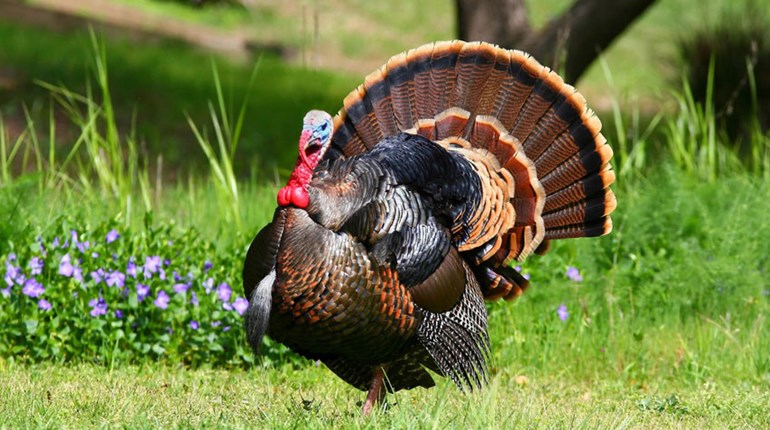
The bright leaves were half down and the rest were blowing free off oaks and maples on autumn breaths of wind. The sky was deep-water blue and crisp with the humidity all gone. The leaves underfoot were fresh and damp from night rains washed away on northwest wind. A grouse was drumming far down the mountain where I knew I’d never see him flush, as he was in a bottom thick with saplings that still had all their leaves.
I was counting on other grouse moving up now into wild grape tangles along stone walls some farmer with calloused hands built over a century before. This area in New York’s Catskill Mountains hasn’t been logged since the end of the 19th century when loggers targeted spruce for the tannin in its bark and then left without paying their taxes. As the forests were then mostly cut and cleared from the East the state got its hands on some 700,000 acres of land here, partially on account of those unpaid taxes, and amended its constitution (Article 14) to forever forbid logging on its state parklands.
I point this out to let you know this is hardly a grouse haven, as ruffed grouse do best at the edges and in young forests that give them plentiful food and cover from hawks and horned owls. Still, the grouse are there and you can find them if you understand the habitat well enough.
Soon the first flush boomed out of tangles of vines purple with wild grapes. I only caught a blur as it went behind trees. I inched forward with my shotgun shouldered, expecting another flush. It came and the grouse blew red leaves off an oak as it twisted left and my first shot was behind but my second right on him.
Just like that a grouse was in the fallen but still red and gold autumn leaves. Before I could pick it up and marvel at its subtle beauty, I heard a shout from far below. Soon a man with a Brittany that seemed to be propelled by its churning tail was coming up the slope to me.
As I watched him climb I wondered if the young are interested in upland hunting anymore. Every bird hunter I run into in the East seems to have stumbled over 50 and is shuffling on stiff legs beneath a content smile into retirement.
I sat on the stone wall and waited for him with the grouse in my hands and my shotgun leaning behind. I was watching his dog and I laughed when it found the spot where my bird had fallen and it began to furiously circle, its nose pushing up the loose leaves.
I’ve often found that if a grouse or woodcock hunter doesn’t have a Brittany or a Labrador dancing around him then often his dogs are gone and he’s too melancholy about the loss of them to train and love another. Either way, he’ll soon tell you, as upland hunters never grow tired of talking about their dogs.
“I see you got one,” he said between sucking in gasps of mountain air. “I heard two, maybe three flush. They wouldn’t hold for a point.”
“It’s no good down low now,” I said, “too many leaves. But the birds are starting to move up as the young birds break into singles. This one was eating grapes.”
He sat down in a pile in front of a tree so old it had roots popping up like armrests.
As he settled I thought I like running into bird hunters, especially those who are alone. The shared passion often means that soon you both are speaking as openly as old friends long parted. Deer hunters, by comparison, are a secretive bunch. Bird hunters more often have an open air about them as their hunts take them to new properties constantly, always in search of flushes and anyway, like waterfowl hunting, upland hunting is a social affair.
“Funny how the birds move upslope all fall,” he said as he looked up, way up to the mountaintop. “Winter hunts always mean going up to the mountain laurel.”
“It’s hard then,” I said. We talked more about the rhythm of knowing and following the grouse and I don’t think we ever exchanged names. He said he couldn’t get his sons, and now his grandsons, to come with him. They’d come once in a while but it was too hard and they didn’t have the time to get in tune with the seasons anyway.
“But it isn’t always so hard,” he said, “there are days, moments in the change of fall to winter when you really get into them when the leaves are almost all down and you can see them flush.”
 I agreed and we talked about when and where these surprising opportunities present themselves as special moments to remember from each season. There were no disagreements between us about this, only additions to the narrative.
I agreed and we talked about when and where these surprising opportunities present themselves as special moments to remember from each season. There were no disagreements between us about this, only additions to the narrative.
We later agreed that part of the reason bird hunting seems to be fading away like hairlines on men over 50 in the East is the forests here have aged too much for good ruffed grouse populations. Still, another part of the reason is so few know how to find and hunt ruffed grouse in aging forests or have the time and resources to drive north to where active logging keeps grouse numbers high enough to keep it exciting. Also, the woodcock come but are soon gone and you have to know how to find them, too. Even the pheasants many states in the East plant in public areas are mostly gone within weeks.
He told me how he, if not overcomes, then at least sidesteps some of the problems associated with hunting grouse on the patchworks of public and private lands in the East. We’d both run into the same obstacles and opportunities. He did have a few pleasant things to add, such as where logging has occurred in the last few decades on private lands alongside state parklands, places with good habitat where no one has posted or minds if you hunt birds. This kind of on-the-ground knowledge takes seasons to earn and few are generous with it. Maybe this older gentleman’s legs weren’t what they used to be or maybe he had simply shot enough so that he didn’t mind giving up his secrets. Whatever the reason, it is always enchanting when two hunters with the same passion compare notes.
Find Grouse in Old Forests
I told him I call the mountainside we were on my “mountain of missed opportunities.”
“Not today,” he said.
“No,” I agreed, “but I’ve missed so many here. They tend to flush wild on this mountainside, especially later in the fall when things get so open. But the real reason is it took me so many years to find and understand this and other places.”
On GoogleEarth, for example, this and many other big-woods areas appear as if they are just unbroken forest. But when you burn out boot soles you find that springs from the mountains often seep onto benches on the mountainsides toppling trees and creating cover. There are also aspen groves and meadows surrounded by patches of raspberries, blueberries and elderberries. There are white acorns, beechnuts and shagbark hickory nuts, too, and where they meet mountain laurel and other cover there are often grouse. But between these places are expanses of old forest that are like deserts between oases of grouse habitat.
Still, up high, especially as the fall moves to winter, often has the best grouse habitat. This is true from Vermont’s Green Mountains to Pennsylvania’s Alleghenies and south and west across Appalachia. If you’ve ever taken I-81 through Pennsylvania or the Skyline Drive in Virginia or other roads that touch the tops of the Eastern mountains then you’ve seen how short the trees can be on top and how much mountain laurel and even blueberry there can be. A lack of good soil up high stunts the trees and storms blow them over, and small trees and bushes that grow fruits and nuts grouse relish, such as dogwoods, sumac and greenbrier, are often found up high.
When snow isn’t covering the ground grouse feed on a wide variety of green leaves, fruits and insects. But when there is snow the grouse shift to eating the dormant flower buds (catkins) of trees such as aspens, birches, cherries, ironwood and filberts. The Ruffed Grouse Society reports that some New England states once had bounties on grouse because of how much these upland birds can impact apple orchards in winter.
I still dream about an abandoned homestead with an overgrown orchard in Vermont located a half-mile from the nearest road that I hunted when in college.
“I still have some special spots like that,” said the old man with the Brittany.
I told him I’d found some new places recently by visiting ruffedgrousesociety.org and using GoogleEarth to view the “Management Area Program Projects.” Just put your mouse over the dots on the map to see the acreage and locations of places where the Ruffed Grouse Society is working with the states to create good grouse habitat.
Of course, we agreed, you don’t have go to the hinterlands to find ruffed grouse. The birds don’t mind living close to us if the cover and food are right. In some areas grouse are actually more abundant in woodlots scattered through suburban areas than they are in remote forests. They thrive best wherever forests are kept young by occasional logging or fire.
My acquaintance told me it’s all about drumming for him. Male grouse are territorial and will use the same drumming log to attract females and to keep away rivals. Often, a grouse will stay in the same 10 acres or so. They’ll move if the cover thins or the food sources force them to, but grouse are homebodies.
Go North for Upland Birds
From northern New England west to New York’s Adirondacks and then to northern Michigan, Wisconsin and Minnesota, there is still a grouse belt where timber companies are active, and we talked about our favorite spots. I love Vermont’s Northeast Kingdom and Maine in October, and I have hunted in Minnesota’s fabled timberlands for grouse. My new friend also likes to hunt in Maine, but he goes to Michigan’s Upper Peninsula a lot where relations have a cabin.
In these northern places grouse populations rise and fall in a much talked-about 10-year cycle that is still poorly understood and that can vary locally.
Finding grouse usually means locating five- to 10-year-old edge cover and cut-overs. In Maine, un-posted logging company lands are often open to public hunting. One classic place is along the Golden Road, a 96-mile road built by the Great Northern Paper Company that stretches from the St. Zacharie border crossing to its former mill at Millinocket.
New Hampshire’s White Mountains also have good populations of ruffed grouse. In Vermont, check state wildlife management areas (WMAs) that are managed for grouse. Some have overgrown apple orchards, abandoned farmlands and regenerating clear-cuts with aspen and birch.
Northern Minnesota and parts of Michigan’s Upper Peninsula and Wisconsin still have enough logging to have fabulous hunting. Scouting via maps and aerial photos online won’t help much, though, as they simply don’t show the cover well. You need to drive up and meet locals and contact game wardens for information. Hiring local guides will often give you a crash course.
Farther south there is still great hunting in West Virginia’s southern coalfields in Boone, McDowell, Mingo, Logan and Wyoming counties, which have many old strip mines the forest is retaking. Wherever you look, asking forest rangers and wildlife biologists where timber cuts have occurred on public lands in the past 10 or so years is always smart.
Grouse habitat, you see, isn’t all fading away. Many states have programs designed to create better habitat. In Kentucky, for example, the state recently published “The Ruffed Grouse and Young Forest Strategic Plan” that took 10 years to formulate. They are now trying to bring various interests together to create more habitat for grouse. “The ideal recipe for grouse is a landscape that is at least 75 percent forested, at least 5,000 to 10,000 acres, and at least 20 to 30 percent young forests,” said Zak Danks, ruffed grouse and wild turkey program coordinator with Kentucky Fish and Wildlife.
Public Put-and-Take Pheasants
Hunting wild, native birds is special, but so is getting an autumn experience of pheasants released into game-management units. States such as Connecticut and New York put out farm-raised pheasants around the opening day of pheasant season. New York releases around 25,000 pheasants on state lands each year. Massachusetts releases about 40,000 pheasants and Connecticut about 15,000 pheasants each year. Many other states do as well. To get in tune with these opportunities you have to contact your state game agency to get an idea where and when they release birds.
Each year I see hunters with bird dogs (people who typically hunt on game farms) hunting up released birds in overgrown fields in New York. They do well, but many of the pheasants quickly run out of the overgrown fields and into nearby ditches and wetlands in the public areas near me. Following these ditches always results in flushes—and with put-and-take birds, follow-up flushes are usually doable. This sort of hunting might not be like it is on the storied grasslands of South Dakota, but the pheasants cackle the same and flush well and still taste good.
Many states also put out pheasants before youth hunts, which generally occur just before the regular season. States often list their pheasant-release sites, especially for youth seasons.
Where and When to Find Woodcock
Woodcock migrate south from southern Canada and areas near the Canadian border each fall. They fly at night and drop into swampy and other riparian areas to feed on invertebrates (mostly worms). The birds might travel alone or in loose flocks called “flights.” Depending on where you hunt and how cold the fall is, the peak migration might be in September or it might be as late as November. To help you find them, The Ruffed Grouse Society developed its “American Woodcock Migration Mapping System” (ruffedgrousesociety.org/migration-map), which relies on local hunters and game officials to log on and report what they are seeing. The data show up as a color-coded map in real time showing you where the woodcock reside. (Don’t forget: Federal law requires woodcock hunters to register with the Migratory Bird Harvest Information Program.)
After talking for a while with this old gentleman about this season of opportunities, even in the East, his Brittany became antsy to hunt up some more birds on the fleeting fall day. So we parted, both knowing soon the leaves would be all down and the window presenting the best hunting would close and we’d hunt on in winter anyway, simply dreaming of another booming flush before the close of another season.





































